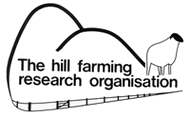Home page
| Re-union 2004
| Staff lists
| Old photos
| Edinburgh meetings
| News
| Contacts
HFRO History
This page has yet to be developed but could include extracts of documents such as the
Introduction to the HFRO First Report 1954-58.
INTRODUCTION
THE HILL FARMING RESEARCH ORGANISATION came into being as an
independent grant-aided research institute on 1st April 1954, follow
ing the decision in 1953 of the Secretary of State for Scotland, in
consultation with the Minister of Agriculture and Fisheries and the
Agricultural Research Council, to create a body for the specific
purpose of promoting research into hill farming problems. This
step marked a further organisational stage in a development that
gathered impetus subsequent to the second world war. The
investigation of the problems of production from hill and upland farms is
not, of course, new, having been pursued by many people since the
start of this century and even earlier. But apart from the work of
the Animal Diseases Research Association and other workers in
the field of animal health, there had only been sporadic
investigations and no systematic approach to the technical problems involved.
Accordingly, when the Balfour of Burleigh Committee reported in
1944 on hill sheep farming in Scotland, it recommended an expansion
of research on a large scale, with the creation of a Hill Farming
Research Station. In England and Wales, the De la Warr Committee, which had
undertaken a corresponding investigation, expressed similar views.
Subsequently, the Agricultural Improvement Council for Scotland was asked to
consider these recommendations and appointed a Committee to suggest how they
should be implemented. Its considered opinion was that there should be three
experimental hill farms in Scotland, one in the area of each of the Colleges of
Agriculture, and that a Hill Farm Research Committee be appointed
to consider a national research programme and arrange for the
delineation of work appropriate to each farm. The Colleges would
be responsible for day to day management of the farms, which would
also provide facilities for visiting workers from Research Institutes,
Colleges and Universities.
These recommendations were gradually put into effect. A Hill
Farm Research Committee was appointed in 1945. Already the
North of Scotland College of Agriculture had obtained, in 1943,
the farm of Glensaugh in Kincardineshire and this became the first
experimental hill farm. In 1946 the East of Scotland College of
Agriculture secured a lease of Sourhope in the Cheviot Hills, and in
1949 the West of Scotland Agricultural College entered into occupation of
Lephinmore on Loch Fyne in Argyll. Thus the chain of
stations recommended in 1944 became complete.
The first Hill Farm Research Committee completed its term of
office and in 1949 issued a report entitled "Hill Farm Research".
It was succeeded by a second Committee, which in 1952 issued
"Hill Farm Research—Second Report". A major recommendation
of this second Committee was that the time had arrived for a further
development by the setting up of a central organisation to control
the three research farms in Scotland and by the appointment to it
of scientific staff devoting their whole time to hill farming problems.
On the acceptance of this proposal by the Secretary of State for
Scotland, the Hill Farming Research Organisation was established
and the three research farms of Glensaugh, Lephinmore and Sourhope transferred
to it on its inception. The Organisation is required:
"to promote and implement a co-ordinated programme of work
subject to the scientific oversight of the Agricultural Research
Council on the problems arising from hill farming which require
further research"
The control of the Organisation rests with a Board of Management, appointed
by the Secretary of State for Scotland, of scientists,
agriculturalists and hill farmers in Scotland, England and Wales.
For the first three years the Organisation was fortunate to have
Professor R. G. White as Chairman of the Board. Professor White
was Chairman of the second Hill Farm Research Committee,
and a member of its predecessor. Moreover, he has been an outstanding
authority on all aspects of sheep farming for nearly half a
century, and his extensive knowledge and experience were of particular
benefit in guiding the Organisation in its early days. Amongst
the other members of the Board for its initial period were the late
Professor T. J. Mackie and Dr J. Russell Greig. Both had long
been concerned with research into animal health, were members
of the Balfour of Burleigh Committee and of each of the Hill Farm
Research Committees, and played a valuable part in formulating
research programmes.
Contact Alan Sibbald: alansibbald13@zzzgmail.com (who likes to call himself the Webmaster!)
if you have any comments or suggestions for this page. Remember to remove the  from my email address before sending.
from my email address before sending.
Top of page




 from my email address before sending.
from my email address before sending.